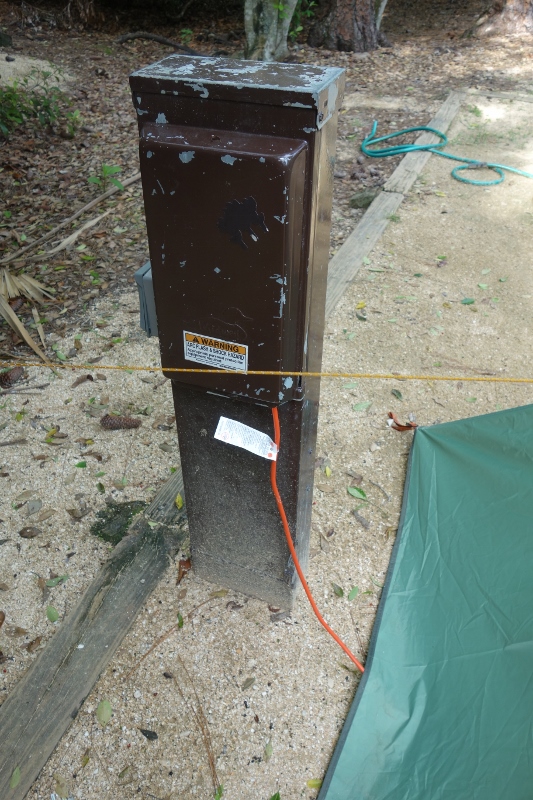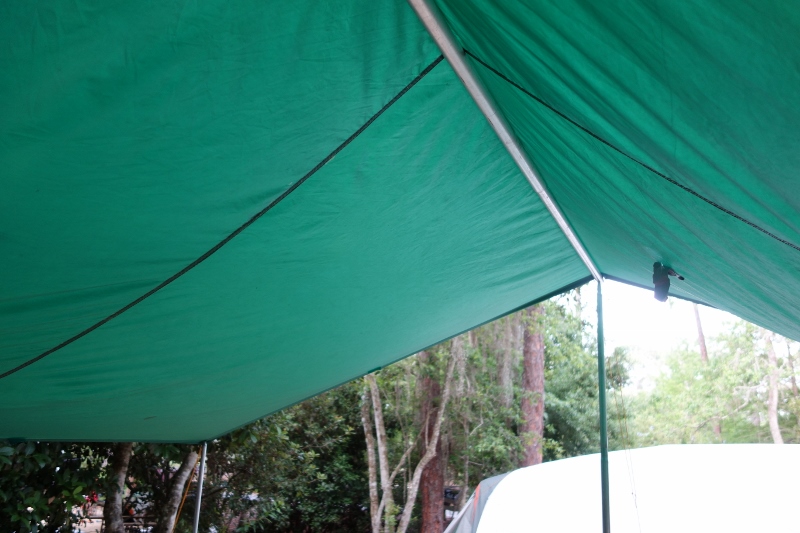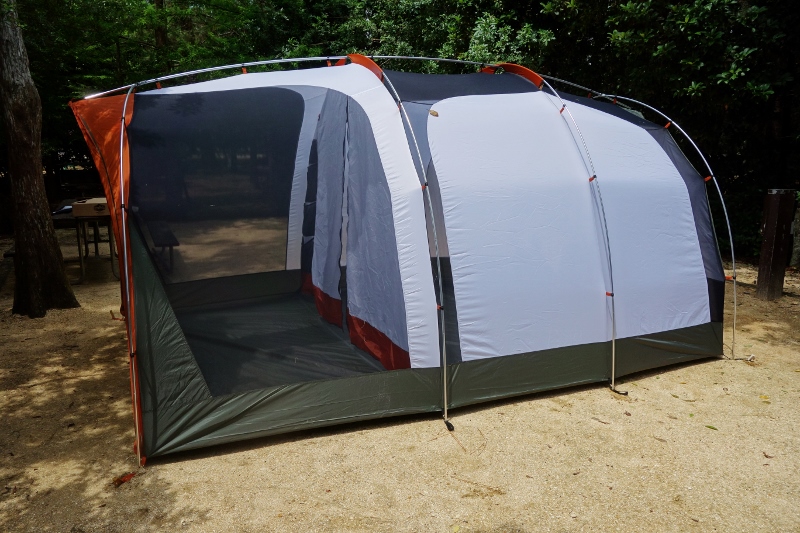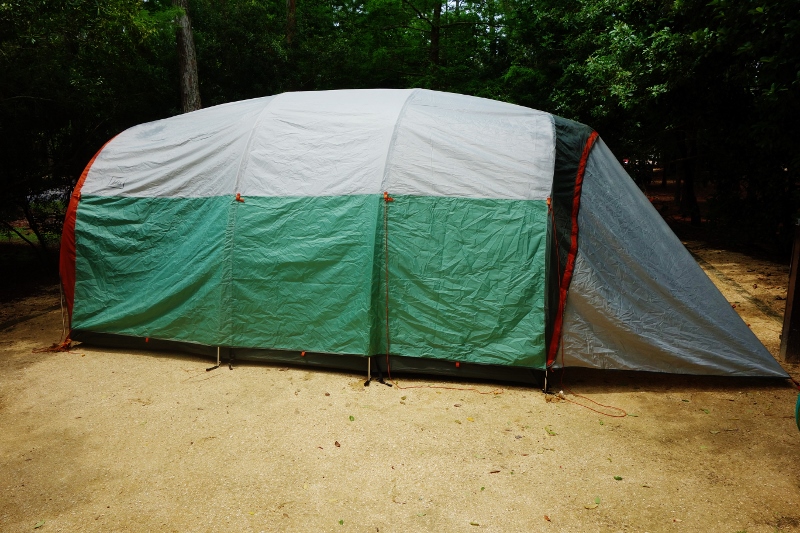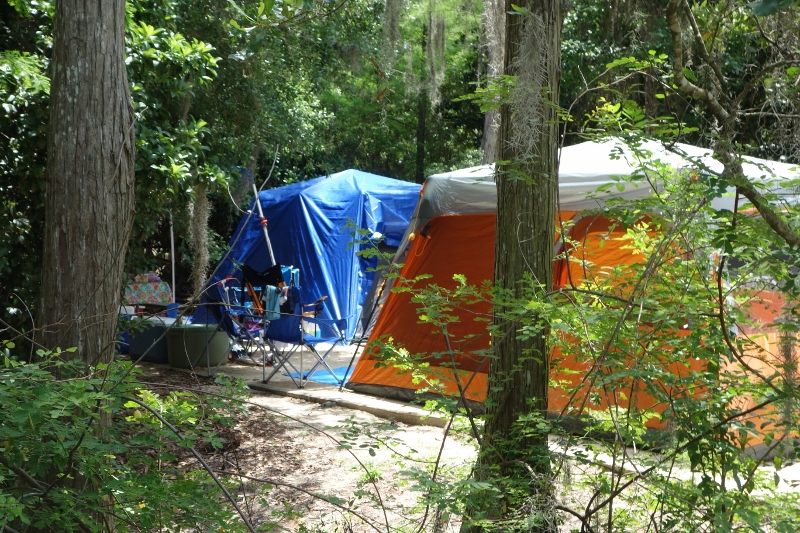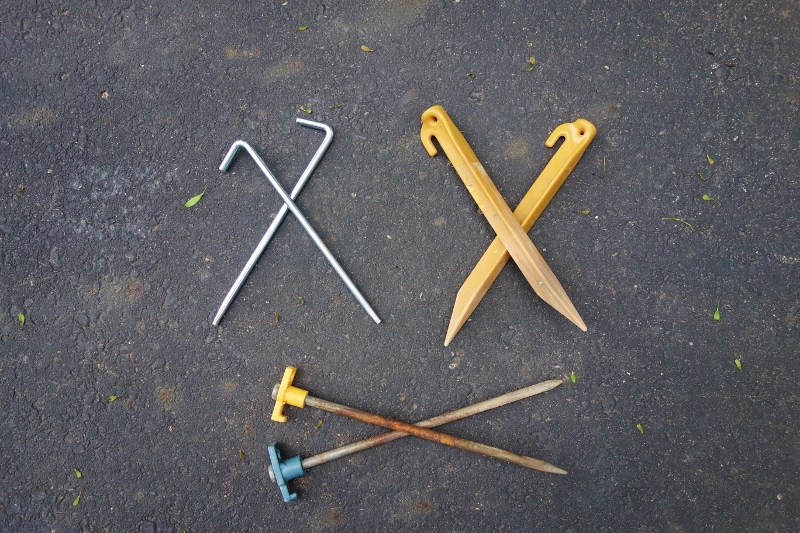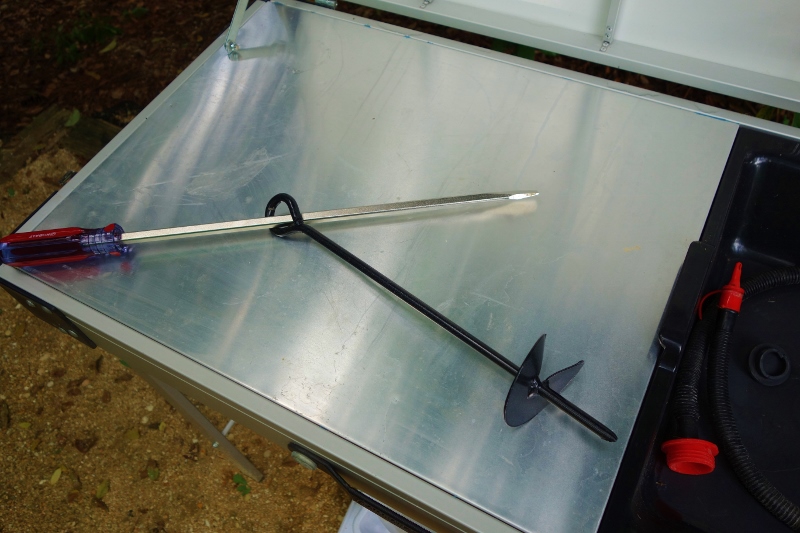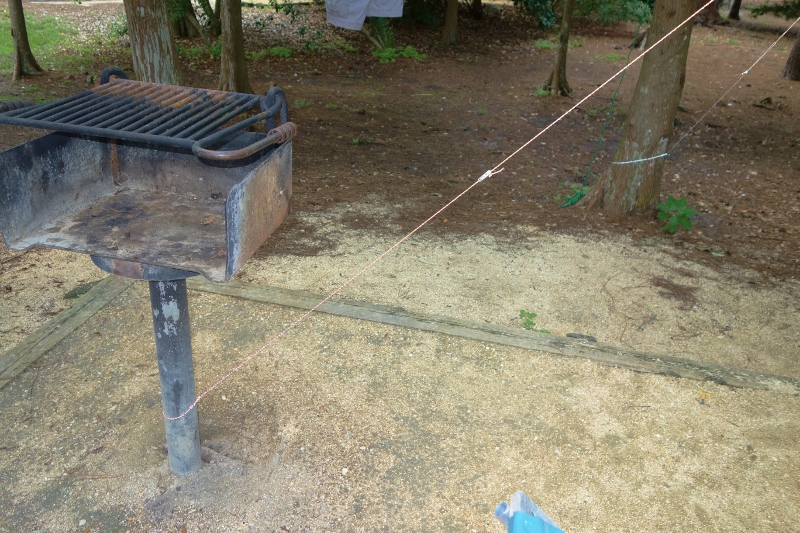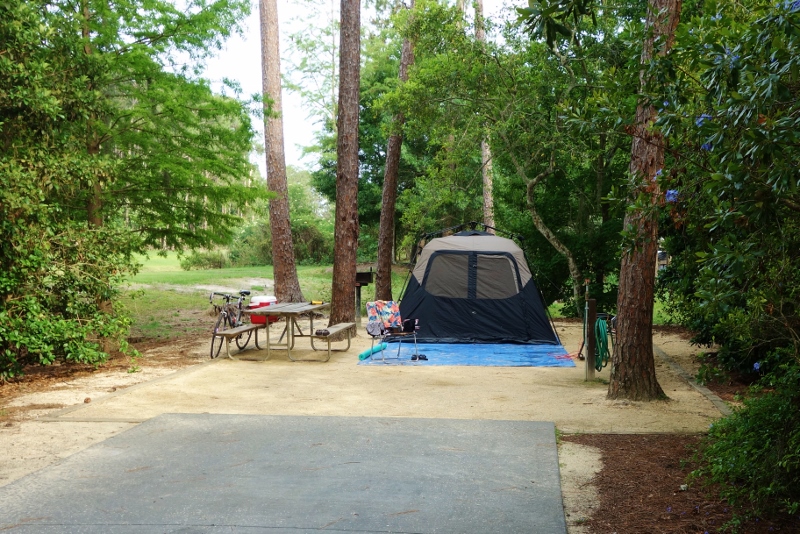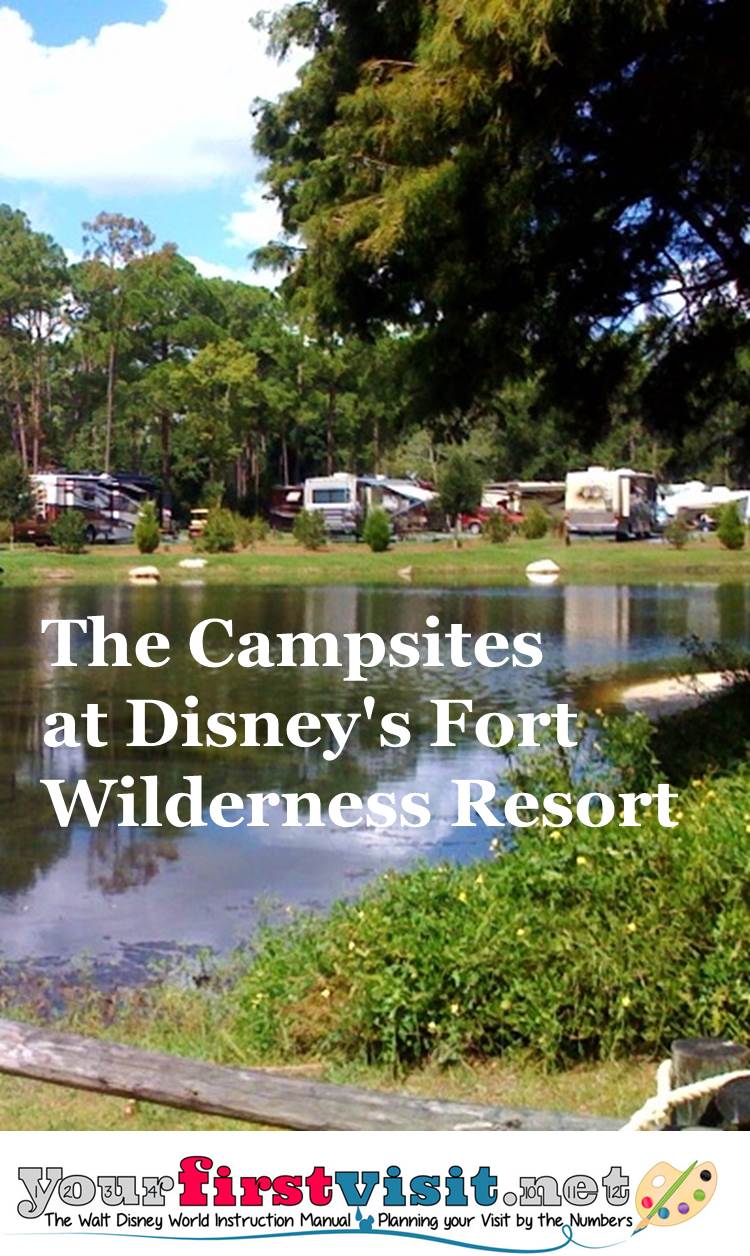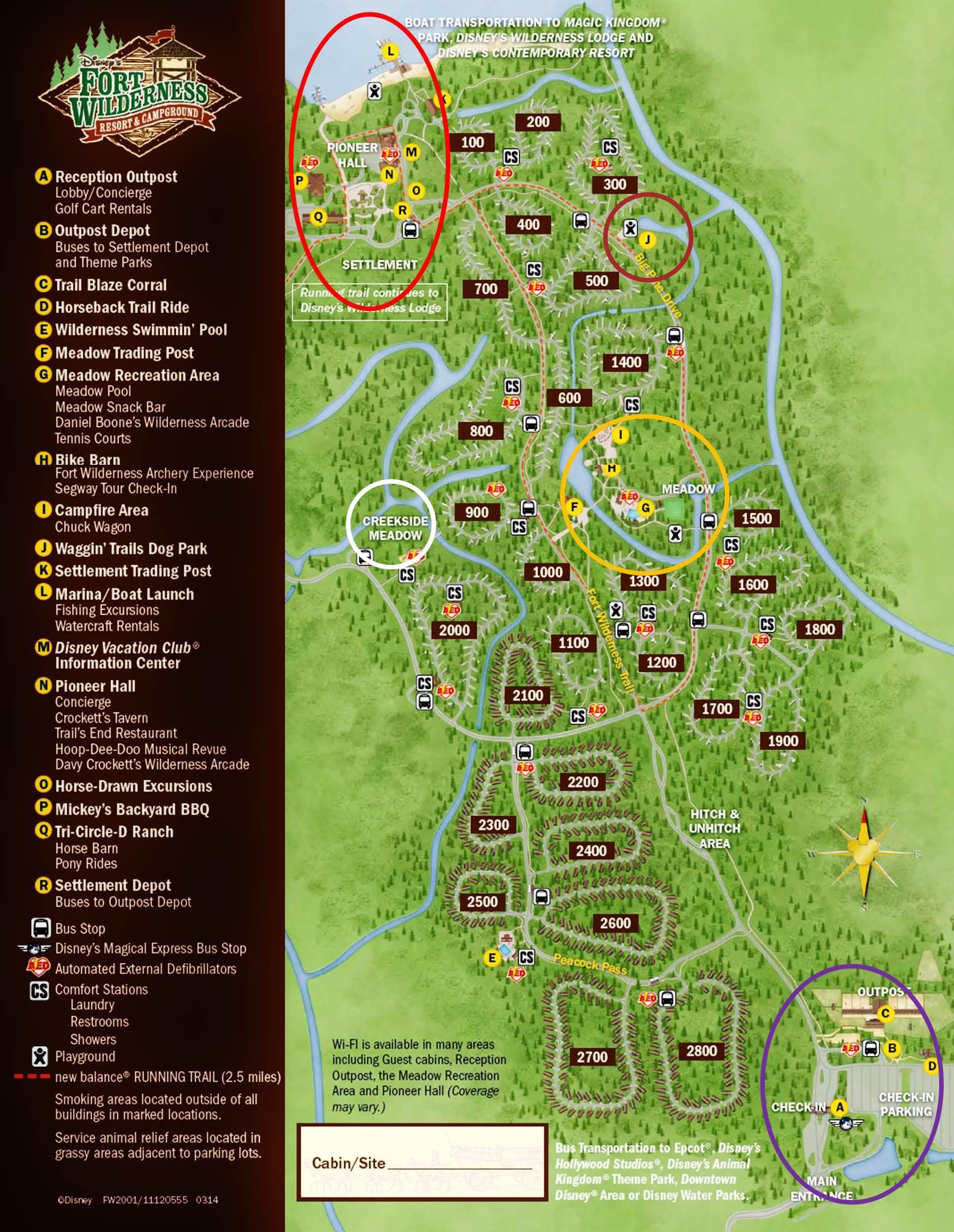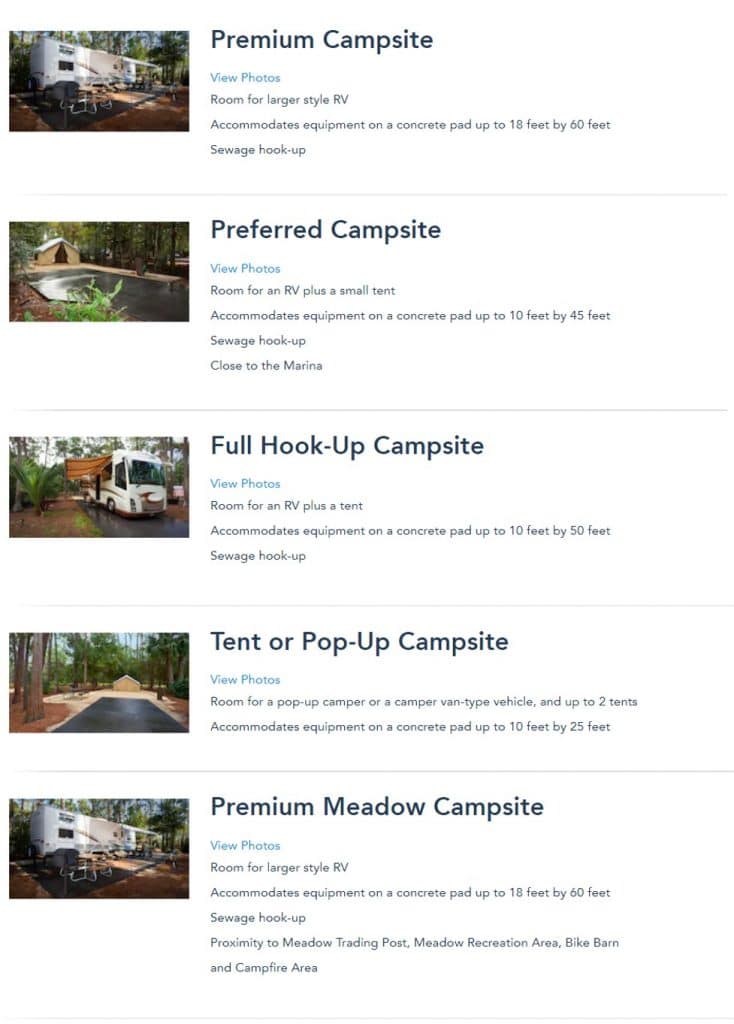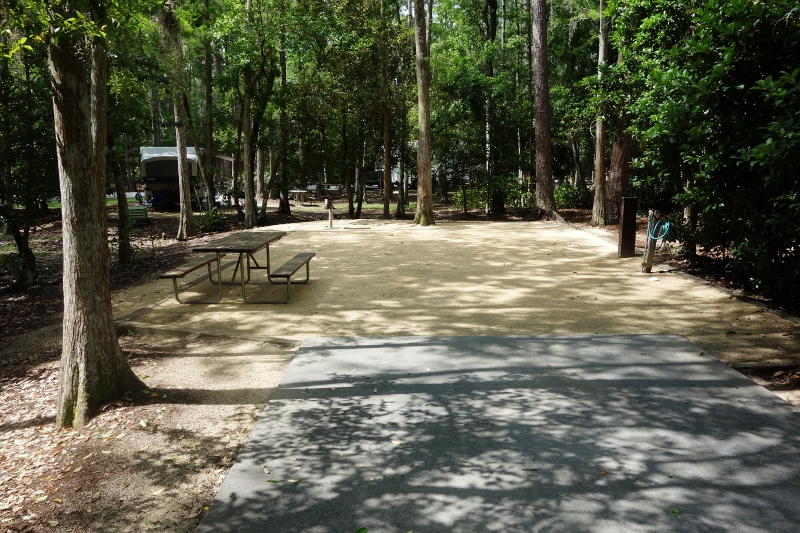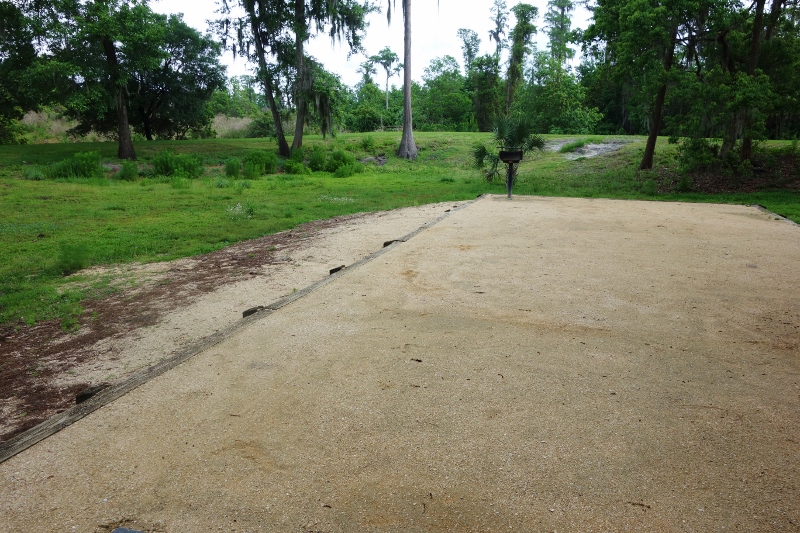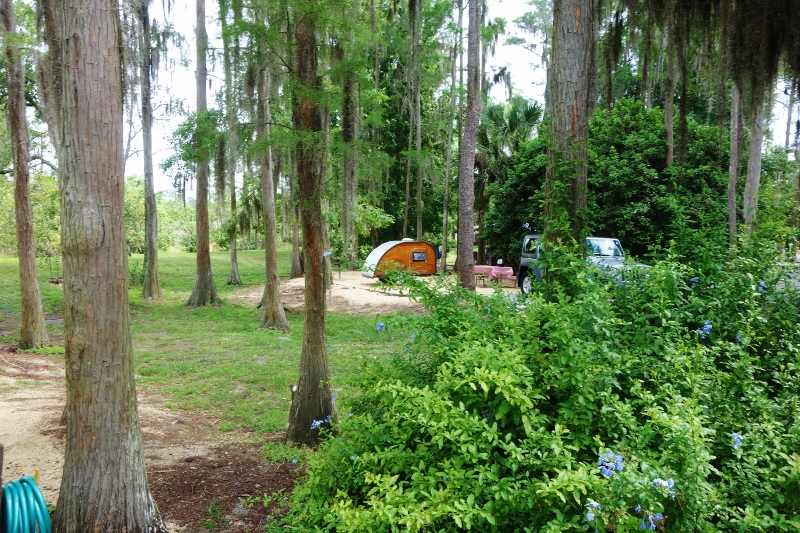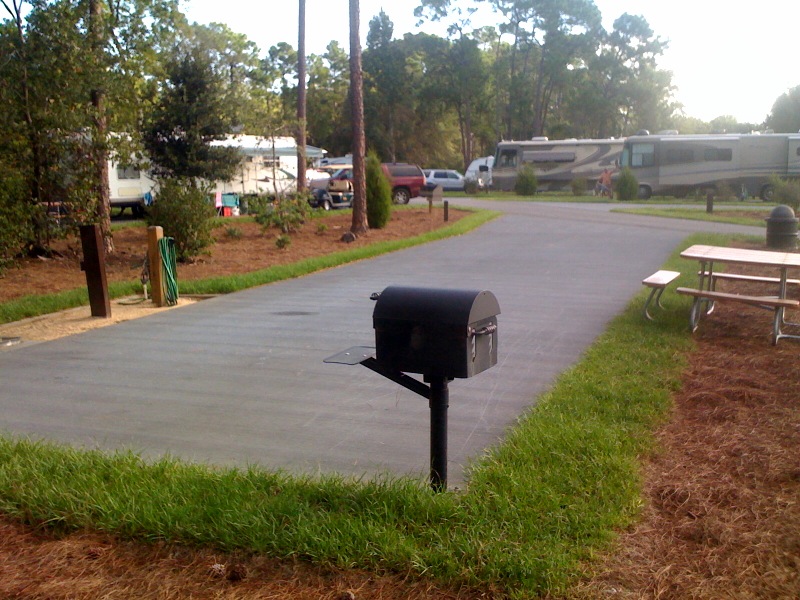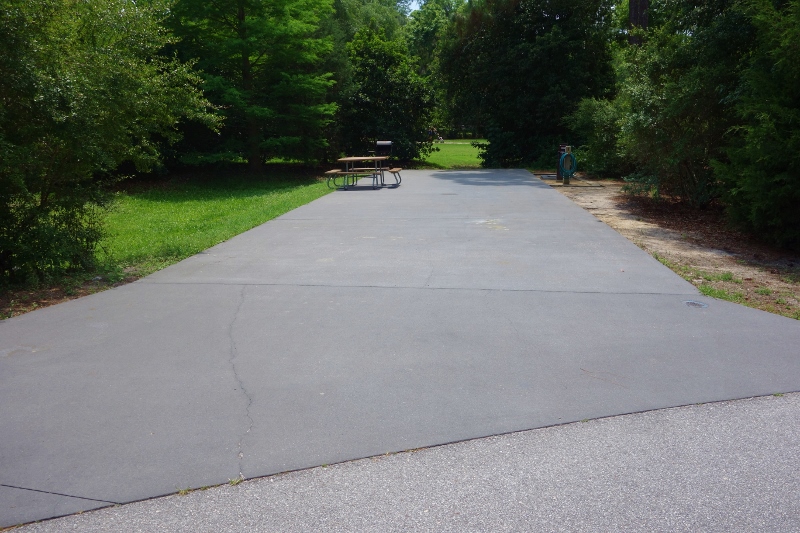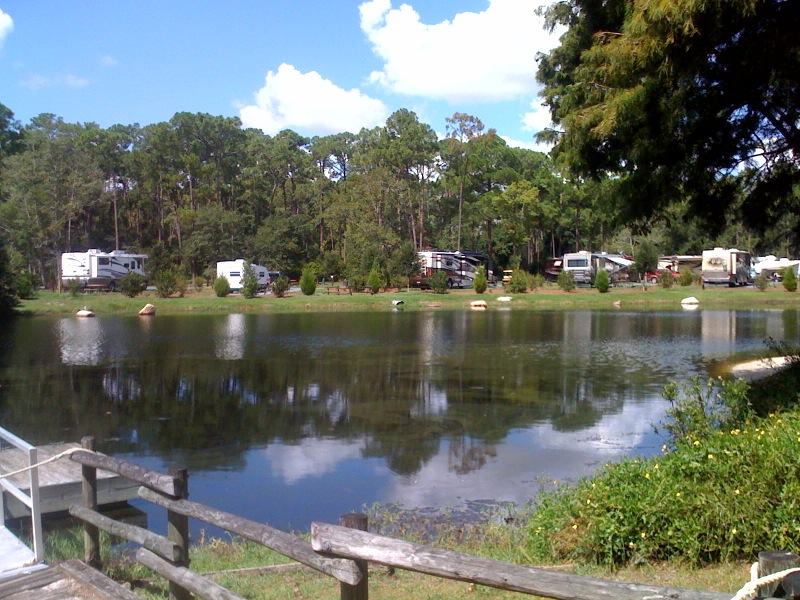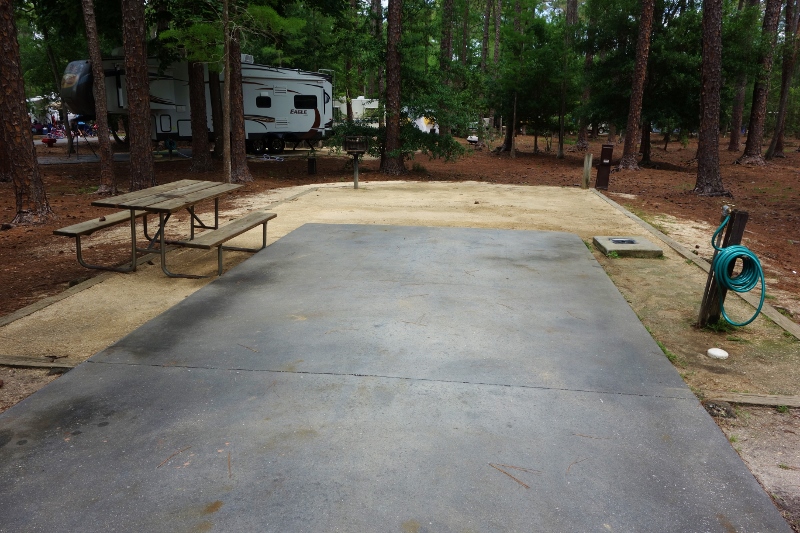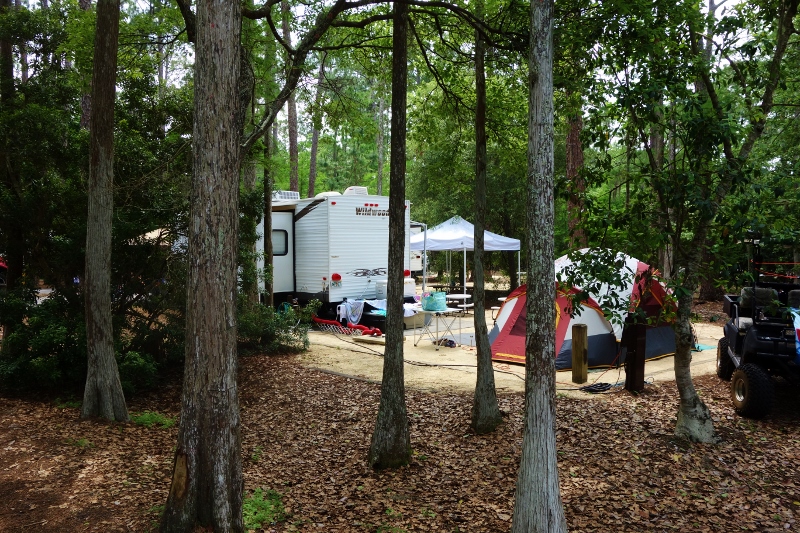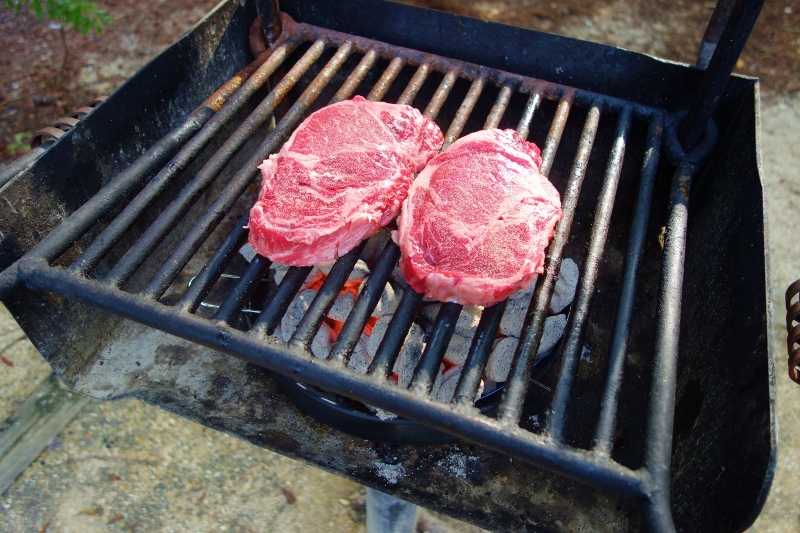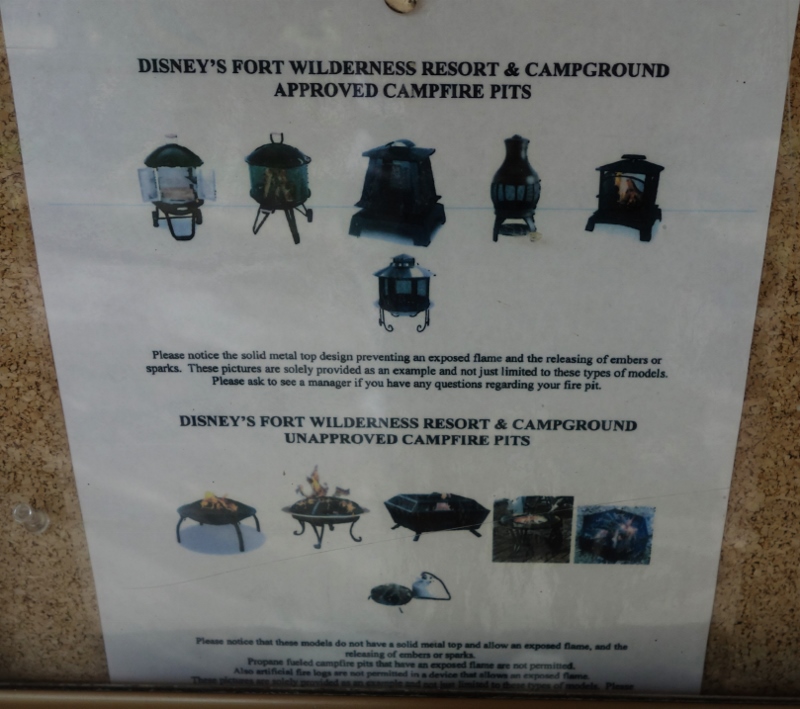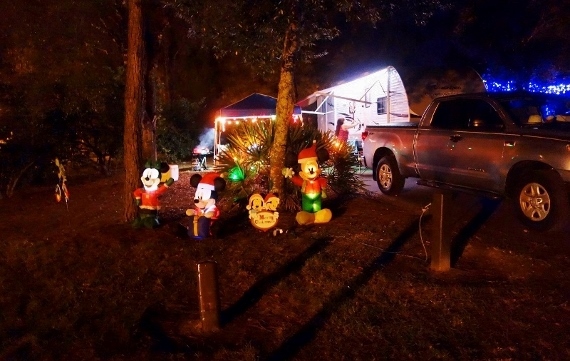Category — d. Where to Stay at Walt Disney World
Review: The Campsites at Disney’s Fort Wilderness Resort, p5
YET EVEN MORE STUFF ON THE CAMPSITES AT DISNEY’S FORT WILDERNESS RESORT
This page continues the review of the campsites at Fort Wilderness that begins here, and covers prices, recommended loops, and odds and ends.
November 28, 2010 7 Comments
Tent Camping Hints for Disney’s Fort Wilderness Resort
(For the first page of this review of Disney’s Fort Wilderness Resort, click here.)
TENT CAMPING HINTS FOR THE CAMPSITES AT FORT WILDERNESS: GEAR AND WEATHER
Even experienced tent campers need to bring the right gear to Fort Wilderness, some of which might be uncommon to their camping styles elsewhere.
Inexperienced campers should think twice about making Fort Wilderness their first tent camping trip.
And everybody except experienced Florida tent campers needs to think hard about the weather.
SPECIAL TENT CAMPING GEAR FOR DISNEY’S FORT WILDERNESS RESORT
Things to keep in mind when gear planning are the sun and heat, common thunderstorms–daily some times of the year–and the sand tent pads.
It can get really, really hot (and humid) in Orlando. So take advantage of the fact that every site has electricity and bring some extension cords and fans. I set up two electric fans for a cross-breeze, one bringing air into and one blowing air out of my tent, and used a battery-powered hanging fan in the peak of my tent to help exhaust hot air.
The sun and rain can really bear down in Florida, so absolutely bring several tarps that you can cobble together into both a dining fly and tacked-on sunshade/blowing rain protector system.
I’m not as keen on self-supporting flies as I am on traditional pole and guy flies, as pole and guy rigs are more forgiving in strong winds. I’ve had three self-supporting flies break on me in storms, while in the same wind a tarp will simply lift off its poles and be easy to set up again (after the wind dies…and after you find it, if you forgot to have at least one guy tied to directly it, rather than simply looping over the pole).
Another rain point–traditional family tents with partial rain flies covering just the top of the tent can be less than adequate in the weather you might face.
Much better is a mesh inner tent with a full-coverage fly, similar in design to a traditional backpacking tent. Roll up the fly in fine weather, bring it down in storms.
Family tents with full coverage rain flies can be hard to find. I love my REI Kingdom 8, which is perfect for Florida camping.
Here’s all the mesh without the fly:
…and here it is with the full-coverage fly fully deployed:
This tent system, when coupled with the fans noted above, can defeat any weather issue except humidity.
If you can’t afford a new tent, then bring a really big blue tarp that you can use in a pinch as a full-coverage fly–see the tent on the left above–enabling you to both avoid the rain and also open your tent’s windows beneath it and get some air into it during a storm.
The not-uncommon windy storms, when combined with the sand tent pads, means you need to bring extra guys and some sand stakes.
Traditional stakes–such as those shown above–simply won’t stay in the sand when the wind is blowing. The metal versions won’t even stay in the ground under simple tension.
After a number of failed experiments–some kinda comic–I’ve settled on the screw-in sand stake shown at the right above (thanks John Koch of Troop 194–you know why!!).
These are available in packs of 8 (with some extra line) on Amazon here.
You literally screw these into the ground, so need something to spin them with and give you torque–thus the 15 inch screwdriver on the left, which also works great as a barbecue poker.
You also need something to link the loops at the end of the stakes to your stake loops or guy lines. For this you could use good carabiners or cord.
Also bring extra guy lines–and of course, where you can, anchor them to fixed parts of the terrain, to avoid having to spin down all those darn sand stakes. Here, at one corner of my dining fly, I have the pole guyed to two fixed points–the barbecue and a tree–and thus don’t need to screw in a sand stake here.
Don’t forget extra guys and sand stakes for your tent!
Modern free-standing designs don’t need them to stand up in no wind–but when the wind blows, without stakes and/or guys, in a storm such tents become “free-ballooning.” I’ve seen un-staked, un-guyed free-standing tents blow away with infants inside…
THINK TWICE BEFORE HAVING FORT WILDERNESS BE YOUR FIRST TENT CAMPING EXPERIENCE
Fort Wilderness resort tent campsites are commonly the least expensive way to access all the perks that come from staying at a Walt Disney World resort, and, since they can be booked for ten, are by far the cheapest way to bring a large family to Disney World.
As a result, too often I see families at Fort Wilderness with a tiny tent with lousy rain protection, a cooler, a bag of charcoal–and that’s it. If they have a ground cloth, they are using it the worst possible way. No flies, no stakes, no guys, no stove, no cooking gear, no cleaning gear, no chairs, no lanterns, no power cords, no fans….
And then the first morning after a storm I see their site abandoned, with their tent stuffed in one of the campground’s trash cans!!
Don’t do this. Gear up for and then test your gear in a better climate first, and only then come to Fort Wilderness with all the extra gear I’ve noted above. (There’s more on the gear we bring later in this review.)
WEATHER AND TENT CAMPING AT DISNEY’S FORT WILDERNESS RESORT
There’s a couple of points of Orlando weather to keep in mind when planning a tent camping trip to Fort Wilderness.
- The winter-spring tornado season runs from February through April
- The summer tornado season runs from June through September
- Afternoon thunderstorms are common in the summer
- The hurricane season runs from June through November, but has its peak from mid-August through mid-October.
So add up the months and you’ll see that the safest months to comfortably tent camp at Walt Disney World are May, December, and January.
That said, no one that I am aware of has ever been injured at Fort Wilderness by a hurricane or a tornado.
I would personally be more concerned about the two tornado seasons than about the hurricane season.
Hurricanes come with substantial advance warning, and Disney shuts down Fort Wilderness when it seems to be in the path of one, moving guests to other Disney resorts. Moreover, they are much less common in June-mid-August, and late October-November.
Based on this, I’d add later October and November to the list of “safe” months for tent campers. (June-mid-August remain in the summer tornado season, and anyway are far too hot for me to consider recommending tent camping then…)
Tornadoes, on the other hand, come with much less notice, and in the winter-spring tornado season, if they do happen, commonly happen in the middle of the night.
I wouldn’t dream of tent camping at Walt Disney World in either tornado season without a tested emergency weather radio, and without doing a test run in the dark to the nearest comfort station, which likely would make a much better hurricane shelter than my tent or car.
All in, my recommended months for tent campers at Fort Wilderness end up being mid-October-January, and May.
Owners of pop-ups should follow the thoughts shared for tent campers; smaller trailers and Class Bs have some of the same vulnerabilities.
Larger trailers, Class As and larger Class Cs are less vulnerable…but if it were me, I’d still avoid the winter-spring tornado season, and the peak of the hurricane season.
A PHOTO TOUR OF A CAMPSITE AT DISNEY’S FORT WILDERNESS RESORT
This review continues here.
TOPICS COVERED IN THIS REVIEW OF DISNEY’S FORT WILDERNESS
- Overview of Disney’s Fort Wilderness Resort & Campground
- Amenities at Fort Wilderness: The Outpost and The Meadow
- Amenities at Fort Wilderness: The Settlement
- The Pools at Fort Wilderness
OTHER KEY PAGES FOR WHERE TO STAY AT DISNEY WORLD
- Where to stay–the Basics
- Where first-timers should stay
- Reviews of all the Disney World resorts, based on my 150+ stays in them
Follow yourfirstvisit.net on Facebook or Twitter or Pinterest!!
November 23, 2010 48 Comments
Review: The Campsites at Disney’s Fort Wilderness Resort, p3
To go to the first page of this review, click here.
MORE STUFF ON THE CAMPSITES AT DISNEY’S FORT WILDERNESS RESORT
Fort Wilderness opened in November 1971, just a month after Walt Disney World opened, and has been expanded and rehabbed multiple times since.
Currently, the entire Fort Wilderness resort comprises not only the campsites, but also cabins, group campgrounds, and shared resources—such as a beach, marina, dining areas, stores, stables, pools, boat docks for transport to the Magic Kingdom (and two other Disney Resorts—the Wilderness Lodge and the Contemporary Resort), etc.
Recently, Disney has begun positioning the cabins at Fort Wilderness differently than the campsites, and has labeled the cabins as moderate resorts. This is a reasonable reflection of the level of amenities in these great cabins, and also makes perhaps a little clearer that at the cabins you aren’t camping. [Read more →]
November 14, 2010 No Comments
Review: The Campsites at Disney’s Fort Wilderness Resort
(For the first page of this review of Disney’s Fort Wilderness Resort, click here.)
THE CAMPSITES AT DISNEY’S FORT WILDERNESS RESORT
Note: guests staying at the campsites at Disney’s Fort Wilderness Resort are eligible for Disney World’s Early Entry program, and for early access to its paid individual system for access to certain rides, but NOT for its Extended Evening Hours.
Fort Wilderness opened in November 1971, just a month after Walt Disney World itself opened, and has been expanded and rehabbed multiple times since.
The entire Fort Wilderness resort comprises not only the campsites, but also cabins, group campgrounds, and shared resources—such as a beach, marina, dining areas, stores, stables, pools, boat docks for transport to the Magic Kingdom (and two other Disney Resorts—the Wilderness Lodge and the Contemporary Resort), etc.
At the Campsites at Disney’s Fort Wilderness Resort, according to Walt Disney World’s website,
“…you’ll find family fun as big as the great outdoors. Nestled on 750 wooded acres of lush pine and cypress trees, the fully-equipped campsites let you camp out in comfort. Time seems to slow down while you wander the quiet trails, and roaming ducks, deer and rabbits add to the sense that you are far away from the bustle of modern civilization.”
The 800 or so campsites occupy the bulk of the resort and are grouped in 20 loops, numbered 100 through 2100.
Because…
- Different areas of the campground have different amenities
- Fort Wilderness is sprawling and inconvenient to get around, and
- Some loops are optimized for particular types of gear, and
…picking the best loop for the specifics of your trip is a key decision.
I’ll start with the different areas of the resort and then move on to loop types. For the areas of the resort, follow along on the map (click it to enlarge it).
Check-in is at the southern section of the resort. This area, called the Outpost, is circled (“ovalled”??) at the bottom right in purply-blue. Here you’ll find trail rides and all park, water park, and Disney Springs transport except to the Magic Kingdom (Magic Kingdom transport is via boats from the Settlement, at the far north end of the resort). Internal buses also stop here.
As you head into the resort, you’ll pass the loops with cabins on your left. A quiet pool is in this area as well, open to all Fort Wilderness guests, not just those staying in cabins, but there’s no camping loop it’s particularly convenient to.
Ahead you’ll find a four-way stop sign. Go left and you’ll get to Creekside Meadow, the group camping area, circled in white. When full, Creekside Meadow can hold more than 160 happy, boisterous youth…a point we will return to.
If instead you go straight, you’ll pass the Meadow area, circled in yellow on the map, where you’ll find the main themed pool, a shop, bike rentals and boat rentals, the campfire program area, playgrounds, sports areas, and other amenities.
Keep heading north and you will run into the Settlement area, circled in red at the top of the map. Here you’ll find docks for boat transport to the Magic Kingdom, and also to the Contemporary Resort and the Wilderness Lodge. Also here is a bus stop to the Wilderness Lodge, another shop, all dining except the offering at the main pool, a marina, the beach, and other amenities.
Also worth noting is the location of the dog park, circled in brown on the top right.
THE FIVE CAMPSITE TYPES AT FORT WILDERNESS
Disney sells five different campsite types: Tent or Pop-Up, Full Hook-Up, Preferred, Premium, and Premium Meadow.
While all campsites allow one rig or tent, plus also a second tent (and can be booked for up to ten people) there are profound differences among the types, plus other points worth noting.
TENT OR POP-UP SITES AT FORT WILDERNESS
Some loops are optimized for tent camping and have small asphalt areas and large sand (technically coquina) tent pads.
Disney used to call these “Partial Hook Up” sites, and is now more commonly calling them “Tent or Pop-Up Sites.”
You can book them for tent camping or for a pop-up or camper van. The images are from the 1500 loop. Note that teeny tiny trailers are also permissible.
These sites all have a picnic table, charcoal grill, water and electricity, and internet access is available via a modem kit campers need to pick up (and put a deposit on). Tent campers also need to know some key stuff about gear and weather, which I cover later in this review.
There’s two “Tent or Pop-Up” loops, 1500 and 2000. Loop 1500 is the better choice on almost any dimension, as it is closer to the Meadow area, while 2000 is not only a hike from any amenities, but is also right next to the sometimes-noisy Creekside Meadow group camping area.
PREMIUM AND PREMIUM MEADOW SITES AT FORT WILDERNESS
Some loops have asphalt optimized for 45 foot big rigs and (essentially) no tent pads–loops 400-1400. These sites have longer and wider asphalt, and enhanced shoulder curves to help with the back-in (all Fort Wilderness RV sites are back-in).
You can add a tent too, but it is very likely to be on the asphalt, have no staking ground, and limited guying options. Disney calls these “Premium” or “Premium Meadow” loops. The images are from the 600 loop.
These loops come with a picnic table, charcoal grill, water, electricity, sewer, cable, and available internet access.
More than half the sites at Fort Wilderness are “Premium” sites, so you can find loops tuned to almost any way you plan to camp at the Fort.
- For a Magic Kingdom, dining, or water-sports focused trip, premium loops 400, 500 and 700 are near the Settlement
- For a pool or sing-along/movies focused trip, premium loops 600, 1000, 1300, and 1400 are closest to the Meadow. 600 and 1400 are on the north end of the Meadow area, and hence closest among these four to the Settlement. In my view, for families not certain how they will use Fort Wilderness, 600 and 1400 are thus the best Premium sites.
- Premium loops 1100 and 1200 are not far from the Meadow area, but not as close as the four just discussed.
- Premium loops 800 and 900 look pretty good on the map until you notice how close they are to the potentially noisy Creekside Meadow–especially loop 900, which is connected to Creekside Meadow via a bridge, so tons of youth campers may walk through 900 on their way to the Meadow area.
Recently, Disney has split these Premium loops into two, and offered a new booking class, “Premium Meadow,” for those loops it considers close to the Meadow. Now “Premium Meadow are 600, 800, 900, 1000, and 1400
FULL HOOK-UP SITES AT FORT WILDERNESS
Some loops combine good-sized asphalt with a medium tent pad, and are best for those planning both an RV and a tent, or an RV smaller than the very largest sizes. They are fine for tent-campers who don’t mind camping in a sea of RVs, as well. Disney calls these “Full Hook-Up” loops.
These loops come with a picnic table, charcoal grill, water, electricity, sewer, cable, and available internet access.
The full hook-up loops are loops 1600-1900. Loop 1600 is closest to the Meadow area and best among these for first-timers. The two images are from loop 1600. Loops 1800 and 1900 are among the most isolated loops at the Fort and a bit of a hike from the bus stop, or anything else for that matter.
Also classed by Disney as a full hook-up loop is Loop 2100. Sand pads here are smaller than those in other full hook-up loops. It seems to be designed more for RVs than for campers with both tents and RVs. See this for more on Loop 2100.
PREFERRED LOOPS AT FORT WILDERNESS
Preferred loops have the same characteristics as full-hook up loops–that is, they have both extensive asphalt for rigs plus a sand pad for a tent.
These loops come with a picnic table, charcoal grill, water, electricity, sewer, cable, and available internet access.
What makes the three preferred loops–100, 200 and 300–“preferred” is how close they are to the Settlement. Loop 100 is so close that it can be noisy. Loop 300 is next to the dog park. Loop 200 is probably the best choice overall, although loop 300 is just a bit closer to the Meadow area and to the bus stop.
PICKING YOUR FORT WILDERNESS CAMPSITE
The online check-in form for the campsites lets you directly request a loop, and describe certain features of your rig. Filling this in carefully is particularly important if you have a long and/or slide out rig, and are aiming for any loop other than a premium or premium meadow loop.
CAMPFIRES AT FORT WILDERNESS
Each campsite comes with a charcoal grill.
Don’t count on a campfire at your site otherwise.
If there is no local fire hazard at your campsite during the time you are there, Disney will permit campfires, but only in fully enclosed portable fire pits with solid (not metal mesh) tops and legs that bring them off the ground. See the image for examples of approved and not-approved fire pits. You have to bring these yourself.
In extreme fire conditions–not uncommon in the spring until the rainy season starts in later May–you may be precluded from using your charcoal grill as well.
ODDS AND ENDS
You don’t have to own an RV to do RV camping at Fort Wilderness. Plenty of RV rental sites are located in the Orlando area. Some will even set up your RV at the campground for you!
Tents and cots are available for rent from Fort Wilderness itself. Strictly, they are only for use at one of the group campsites. But call Fort Wilderness–if they are not claimed by groups, they may be made available to you.
Fort Wilderness is a huge favorite and a family tradition for many.
It’s not uncommon for RV owners to camp there for weeks, perhaps cycling in different sets of grandchildren.
Halloween and Christmas decorations put up by campers have become ever more elaborate each year, and make the resort particularly charming and silly at these times of the year–to the extent that the overflow parking can be closed to those without a reservation because of all the sightseers!
The campsites’ biggest negatives are their lack of visual kid appeal, the resort’s sheer size, and its internal bus system, which no matter how well it runs, adds time to every theme park visit.
Returning visitors often find the Campgrounds at Disney’s Fort Wilderness to be a favorite, particularly if they have or rent a car to avoid some of the buses, need space for a large family, and want to enjoy some of the distinct amenities of Fort Wilderness—one of America’s best campgrounds.
TENT CAMPING TIPS FOR DISNEY’S FORT WILDERNESS RESORT
This review continues here.
TOPICS COVERED IN THIS REVIEW OF DISNEY’S FORT WILDERNESS
- Overview of Disney’s Fort Wilderness Resort & Campground
- Amenities at Fort Wilderness: The Outpost and The Meadow
- Amenities at Fort Wilderness: The Settlement
- The Pools at Fort Wilderness
OTHER KEY PAGES FOR WHERE TO STAY AT DISNEY WORLD
- Where to stay–the Basics
- Where first-timers should stay
- Reviews of all the Disney World resorts, based on my 150+ stays in them
Follow yourfirstvisit.net on Facebook or Twitter or Pinterest!!
November 8, 2010 79 Comments
The Comfortable Guide to Where to Stay at Walt Disney World
This is part of The Comfortable Guide to Walt Disney World
OVERVIEW: THE MOST COMFORTABLE PLACE TO STAY AT WALT DISNEY WORLD
This site provides precise instructions elsewhere on where to stay at Walt Disney World. These instructions are designed for typical first time family visitors who are not sure whether or not they will ever return.
This page addresses where to stay at Walt Disney World for a subset of first time visitors: those seeking the most comfortable visit.
It is part of a series about the most comfortable way to visit Walt Disney World. Its companion series is about the most inexpensive way to visit Walt Disney World,
I am publishing both series at the same time so that they also help those who are looking for bargains and deals on some things, so that they can spend more on others!! Links to everything in these two series are at the bottom of the page.
MORE ON THE MOST COMFORTABLE PLACE TO STAY AT WALT DISNEY WORLD
November 3, 2010 No Comments
Review: The Campsites at Disney’s Fort Wilderness Resort
Where to Stay Resort Features by Price Resort Kid Appeal Large Families
The Campsites at Fort Wilderness The Cabins at Fort Wilderness
OVERVIEW: THE CAMPSITES AT DISNEY’S FORT WILDERNESS RESORT
Disney’s Fort Wilderness Resort has three types of accommodations:
- Air-conditioned cabins sleeping six with full kitchens (click here for a review of the cabins)
- Group campsites, which I’ll review if I can ever get my scout troop to make the 1100 mile drive to Walt Disney World
- Family campsites, which are the topic of this review
The Campsites at Disney’s Fort Wilderness Resort, while wonderful for returning visitors who like to camp and for RV owners, are at the bottom of the list of recommended resorts for typical first time family visitors to Walt Disney World.
November 2, 2010 10 Comments

